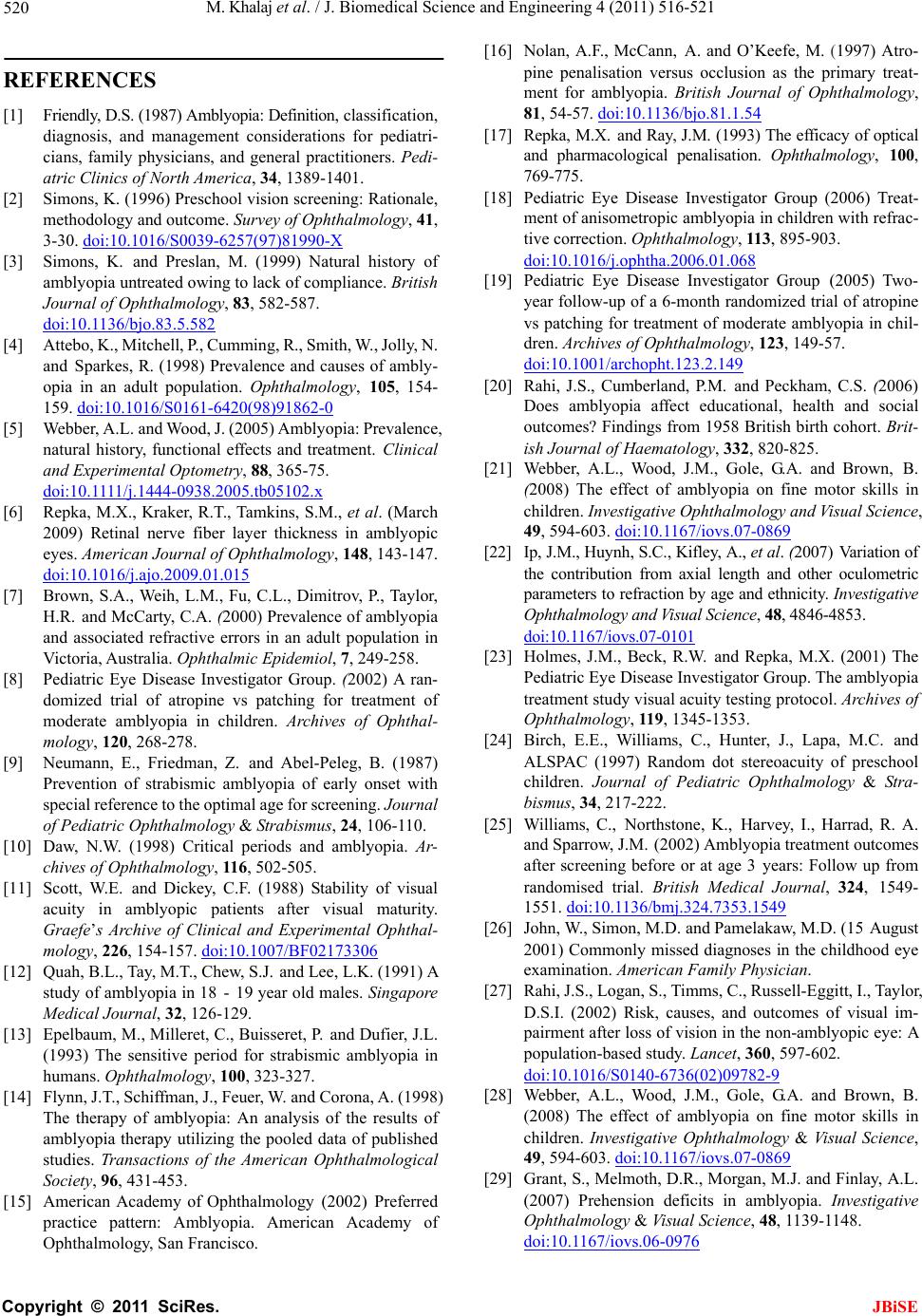
M. Khalaj et al. / J. Biomedical Science and Engineering 4 (2011) 516-521
520
REFERENCES
[1] Friendly, D.S. (1987) Amblyopia: Definition, cl assification,
diagnosis, and management considerations for pediatri-
cians, family physicians, and general practitioners. Pedi-
atric Clinics of North America, 34, 1389-1401.
[2] Simons, K. (1996) Preschool vision screening: Rationale,
methodology and outcome. Survey of Ophthalmology, 41,
3-30. doi:10.1016/S0039-6257(97)81990-X
[3] Simons, K. and Preslan, M. (1999) Natural history of
amblyopia untreated owing to lack of compliance. British
Journal of Ophthalmology, 83, 582-587.
doi:10.1136/bjo.83.5.582
[4] Attebo, K. , Mitchell , P. , Cumming, R., Smith, W., Jolly , N .
and Sparkes, R. (1998) Prevalence and causes of ambly-
opia in an adult population. Ophthalmology, 105, 154-
159. doi:10.1016/S0161-6420(98)91862-0
[5] Webber , A.L. and Wood, J. (2005) Amblyopia: Prevalence,
natural history, functional effects and treatment. Clinical
and Experimental Optometry, 88, 365-75.
d oi:10.1111 /j.14 44-0938.2005.tb05102.x
[6] Repka, M.X., Kraker, R.T., Tamkins, S. M., et al. (March
2009) Retinal nerve fiber layer thickness in amblyopic
eyes. American Journal of Ophthalmology, 148, 143-147.
doi:10.1016/j.ajo.2009.01.015
[7] Brown, S.A., Weih, L.M., Fu, C.L., Dimitrov, P., Taylor,
H.R. and McCa rty, C.A. (2000) Prevalence of amblyopia
and associated refractive errors in an adult population in
V ictoria, Australia. Ophthalmic Epidemiol, 7, 249-258.
[8] Pediatric Eye Disease Investigator Group. (2002) A ran-
domized trial of atropine vs patching for treatment of
moderate amblyopia in children. Archives of Ophthal-
mology, 120, 268-278.
[9] Neumann, E., Friedman, Z. and Abel-Peleg, B. (1987)
Prevention of strabismic amblyopia of early onset with
special reference to the optimal age for sc reening. Journal
of Pediatric Ophthalmology & Strabismus, 24, 106-110.
[10] Daw, N.W. (1998) Critical periods and amblyopia. Ar-
chives of Ophthalmology, 116, 502-505.
[11] Scott, W.E. and Dickey, C.F. (1988) Stability of visual
acuity in amblyopic patients after visual maturity.
Graefe’s Archive of Clinical and Experimental Ophthal-
mology, 226, 154-157. doi:10.1007/BF02173306
[12] Quah, B.L., Tay, M.T., Ch ew, S.J. and Lee, L.K. (1991) A
study of amblyopia in 18 - 19 year old males. Singapore
Medical Journal, 32, 126-129.
[13] Epelbaum, M., Milleret, C., Buisseret, P. and Dufier, J.L.
(1993) The sensitive period for strabismic amblyopia in
humans. Ophthalmology, 100, 323-327.
[14] Flynn, J.T., Schiffman, J., Feu er , W. and Corona, A. (1998)
The therapy of amblyopia: An analysis of the results of
amblyopia therapy utilizing the pooled data of published
studies. Transactions of the American Ophthalmological
Society, 96, 431-453.
[15] American Academy of Ophthalmology (2002) Preferred
practice pattern: Amblyopia. American Academy of
Ophthalmology, San Francisco.
[16] Nolan, A.F., McCann, A. and O’Keefe, M. (1997) Atro-
pine penalisation versus occlusion as the primary treat-
ment for amblyopia. British Journal of Ophthalmology,
81, 54-57. doi:10.1136/bjo.81.1.54
[17] Repka, M.X. and Ray, J.M. (1993) The efficacy of optical
and pharmacological penalisation. Op hthalmol ogy, 100,
769-775.
[18] Pediatric Eye Disease Investigator Group (2006) Treat-
ment of anisometropic amblyopia in children with refrac-
tive correction. Ophthalmology, 113, 895-903.
doi:10.1016/j.ophtha.2006.01.068
[19] Pediatric Eye Disease Investigator Group (2005) Two-
year follow-up of a 6-month randomized trial of atropine
vs patching for treatment of moderate amblyopia in chil-
dren. Archives of Ophthalmology, 123, 149-57.
doi:10.1001/archopht.123.2.149
[20] Rahi, J.S., Cumberland, P.M. and Peckham, C.S. (2006)
Does amblyopia affect educational, health and social
outcomes? Findings from 1958 British birth cohort. Brit-
ish Journal of Haematology, 332, 820-825.
[21] Webber, A.L., Wood, J.M., Gole, G.A. and Brown, B.
(2008) The effect of amblyopia on fine motor skills in
children. Investigative Ophthalmology and Visual Science,
49, 594-603. doi:10.1167/iovs.07-0869
[22] Ip, J.M., Huynh, S.C., Kifley, A., et al. (2007) Variation of
the contribution from axial length and other oculometric
parameters to refraction by age and ethnicity. Investigative
Ophthalmology and Visual Science, 48, 4846-4853.
doi:10.1167/iovs.07-0 101
[23] Holmes, J.M., Beck, R.W. and Repka, M.X. (2001) The
Pediatric Eye Disease Investigator Group. The amblyopia
treatment study visual acuity testing protocol. Archives of
Ophthalmology, 119, 1345-1353.
[24] Birch, E.E., Williams, C., Hunter, J., Lapa, M.C. and
ALSPAC (1997) Random dot stereoacuity of preschool
children. Journal of Pediatric Ophthalmology & Stra-
bismus, 34, 217-222.
[25] Williams, C., Northstone, K., Harvey, I., Harrad, R. A.
and Sparrow, J.M. (2002) Amblyopia treatment outcomes
after screening before or at age 3 years: Follow up from
randomised trial. British Medical Journal, 324, 1549-
1551. doi:10.1136/bmj.324.7353.1549
[26] John, W., Simon, M.D. and Pamelakaw, M.D. (15 August
2001) Commonly missed diagnoses in the childhood eye
examination. Amer ican Family P hysician.
[27] Rahi, J.S., Logan, S., Timms, C., Russell-Eggitt, I., Taylor,
D.S.I. (2002) Risk, causes, and outcomes of visual im-
pairment after loss of vision in the non-amblyopic eye: A
population-based study. Lancet, 360, 597-602.
doi:10.1016/S0140-6736(02)09782-9
[28] Webber, A.L., Wood, J.M., Gole, G.A. and Brown, B.
(2008) The effect of amblyopia on fine motor skills in
children. Investigative Ophthalmology & Visual Science,
49, 594-603. doi:10.1167/iovs.07-0869
[29] Grant, S., Melmoth, D.R., Morgan, M.J. and Finlay, A.L.
(2007) Prehension deficits in amblyopia. Investigative
Ophthalmology & Visu a l Science, 48, 1139-1148.
doi:10.1167/iovs.06-0976
C
opyright © 2011 SciRes. JBiSE